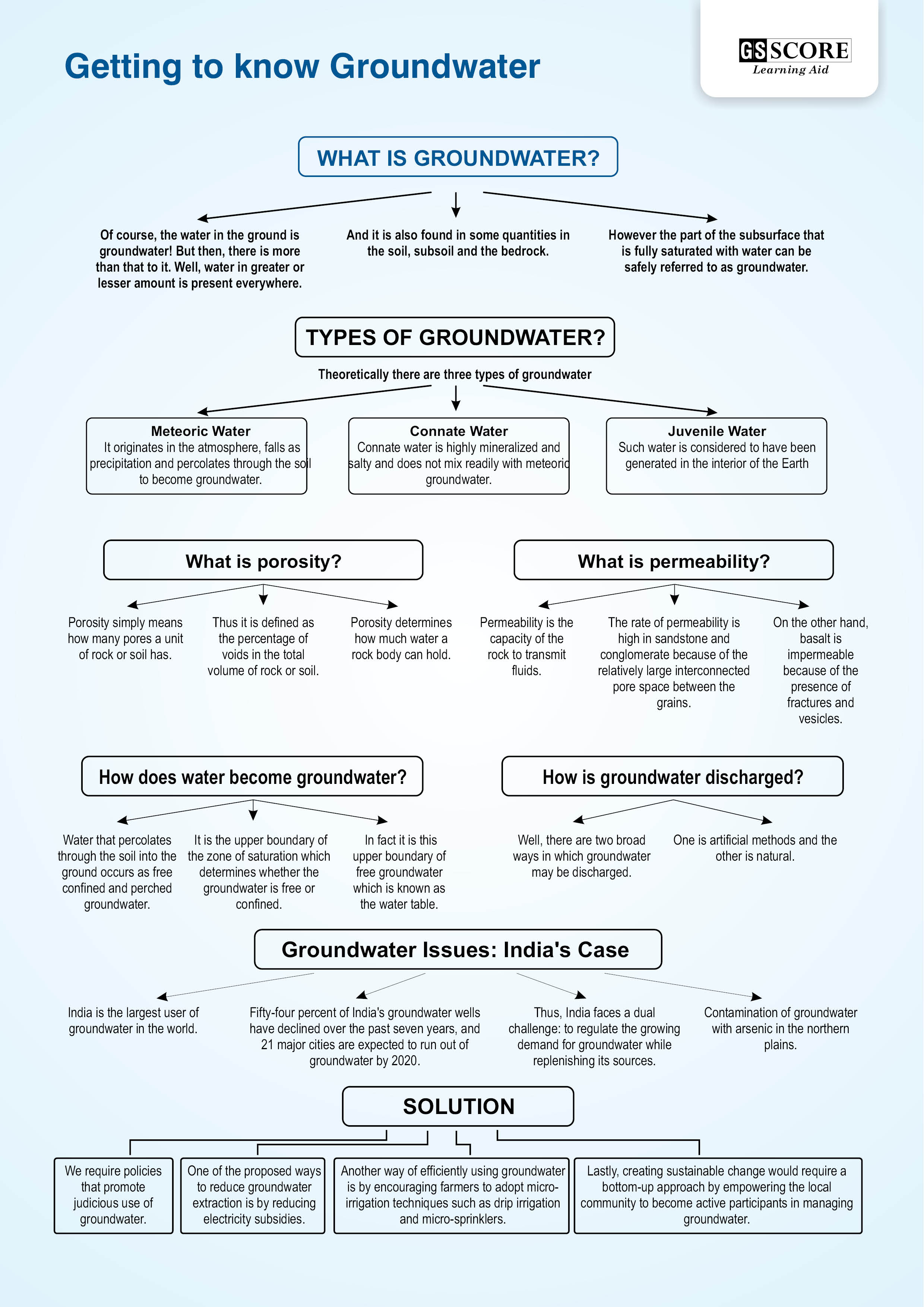

- Porosity simply means how many pores a unit of rock or soil has.
- Thus it is defined as the percentage of voids in the total volume of rock or soil.
- Porosity determines how much water a rock body can hold.
- The various factors affecting porosity are the shape, arrangement and degree of sorting of the constituent particles and the extent to which changes have occurred as a result of solution, compaction, cementation and faulting.
- The irregularity of the particle shape has a more important effect on the porosity than the particle size.
- Permeability is the capacity of the rock to transmit fluids.
- The rate of permeability is high in sandstone and conglomerate because of the relatively large interconnected pore space between the grains.
- On the other hand, basalt is impermeable because of the presence of fractures and vesicles.
- Of course, the water in the ground is groundwater! But then, there is more than that to it. Well, water in greater or lesser amount is present everywhere.
- And it is also found in some quantities in the soil, subsoil and the bedrock.
- However the part of the subsurface that is fully saturated with water can be safely referred to as groundwater.
Now, what is fully saturated?
- You see there are pore spaces in the earth.
- When these pore spaces are fully filled with water it is known as saturated.
- The water that fills these spaces may either be of external origin (derived from the atmosphere or surface water) or of internal origin (derived from the interior of the Earth).
- Well, you might be surprised to note that the interior of the earth does hold some water that is not derived from the atmosphere.
- We even have a name for this saturated layer that contains a whole lot of water.
- Yes, it is an aquifer, a Latin word meaning ‘to bear water’.
- This is the geological formation which saturated with water has been exploited by man for centuries.
- Did you know this (groundwater) largest single source of water supply amounts to more than 1 million cubic miles compared to the 30, 000 cubic miles of world’s streams, rivers and fresh water lakes and moreover this huge expanse of water is available at depths of less than half-mile in an average.
- Well, there are two broad ways in which groundwater may be discharged. One is artificial methods and the other is natural. First the natural method! This includes,
- evapo-transpiration, particularly in the low lying areas where the water table is close to the ground surface;
- effluent seepage into surface water bodies, especially where the aquifer flows into a water body such as a lake or a river.
- leakage through aquicludes in to the adjacent aquifers and
- spring flow
- Springs are an interesting feature.
- The groundwater discharge through springs occurs in areas where the upper surface of the zone of saturation intersects the ground surface.
- Springs are different from seepage.
- Springs appear in the form of concentrated discharge of groundwater, a seepage area on the other hand is the slower movement of groundwater to the surface.
- Springs are classified into several categories.
- First is the depression spring in which the groundwater flows to the surface from a permeable aquifer.
- Then there is the contact springs that occurs where the contact plane between a permeable and impermeable rock intersects the ground surface in such a way that the groundwater is deflected to the surface.
- The contact spring is found at the foot of limestone or chalk escarpment, foot of a scree slope and also along a fault line.
- Fracture springs occur when a system of interconnected minor faults leads the groundwater to the surface.
- Another type is the tubular spring whereby groundwater moves through lava tubes or in solution enlarged interstices in limestone.
- And last but not the least is the spring which arises from hydrostatic pressure.
- Second is the artificial abstraction.
- As for artificial abstraction, it is story all of you must be familiar with. It has adversely affected storage in many areas.
- The groundwater when pumped from wells and boreholes causes a decline in the height of the water surface in the well and results in the formation of a cone of depression around it.
- Successive abstraction from a large number of wells over a long period of time results in the gradual lowering of the water table or the piezomet.

Related Articles

